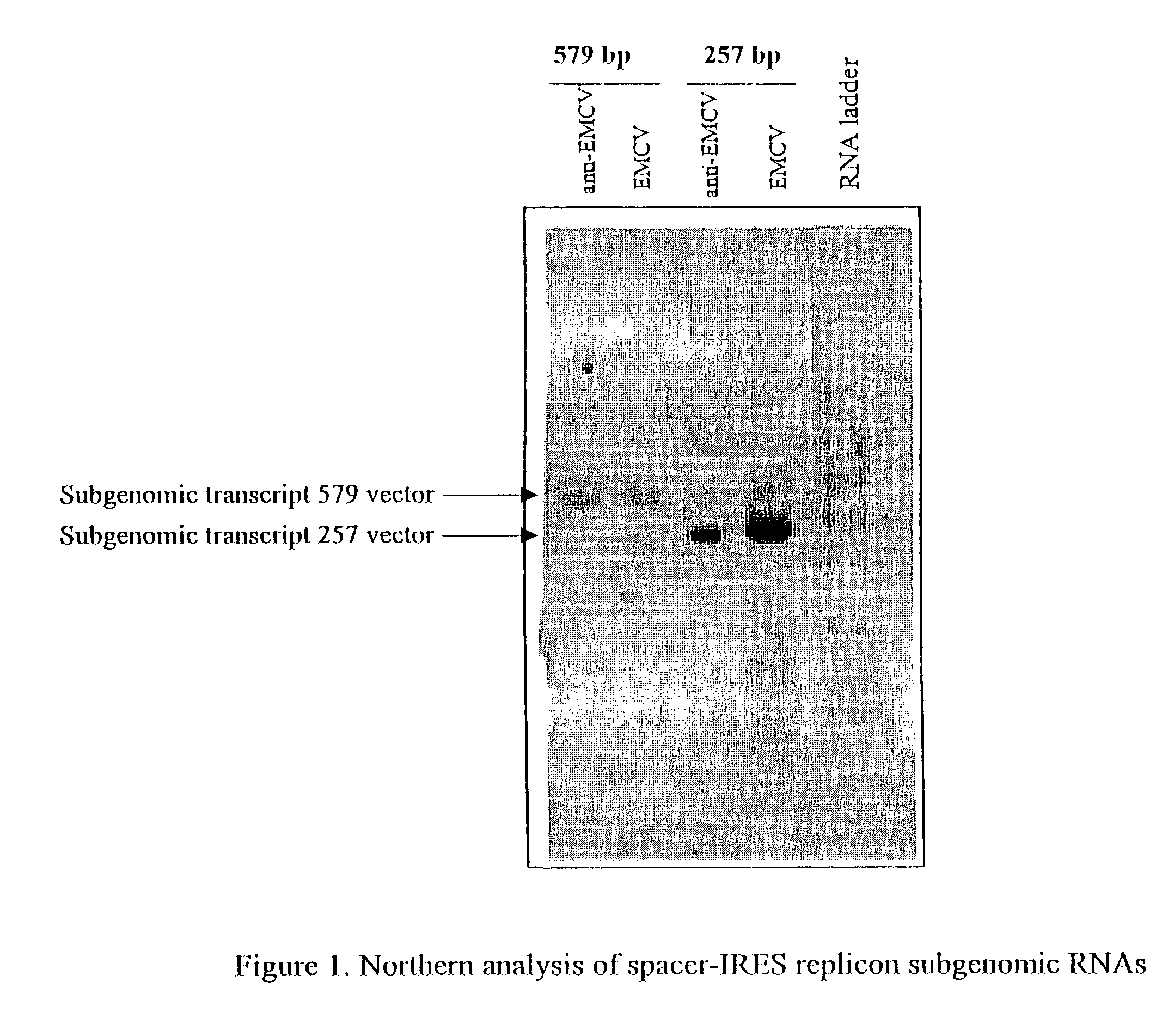Alphavirus replicons and helper constructs
a technology of alphavirus and constructs, applied in the field of alphavirus replicons and helper constructs, can solve the problems of severe compromise or inhibiting cap-dependent initiation
- Summary
- Abstract
- Description
- Claims
- Application Information
AI Technical Summary
Benefits of technology
Problems solved by technology
Method used
Image
Examples
example 1
Construction of Transfer Cloning Vectors
A. EMCV IRES-Containing Vectors
[0099]A transfer vector (pCDNA3.3) was prepared into which the encephalomyocarditis (EMCV) IRES sequence and any NOI could be introduced. Plasmid pCDNA3.1 (+) (Nitrogen) was digested with restriction enzyme Bathe and treated with T4 DNA polymerase to eliminate the unique Bathe restriction site, resulting in generation of pCDNA3.2. The pCDNA3.2 DNA was further digested with restriction enzyme Bay and also treated with T4 DNA polymerase to remove the unique Bay restriction site, resulting in generation of pCDNA3.3.
[0100]An intermediate cloning vector containing the multiple cloning site (MCS) from a VEE replicon vector was prepared by legating an ˜250 bp ApaI / NotI MCS fragment into ApaI / NotI linearized pBluescript KS+ (Stratagene) DNA, generating pKS-rep2. The EMCV IRES was digested from pD1+2+3 (Kaminski et al., 1995) with restriction enzymes EcoRI and BamHI and ligated into EcoRI and BamHI linearized pKS-rep2 DNA...
example 2
Construction of Improved Replicon Vectors
A. Constructs Containing the EMCV IRES
[0105]To demonstrate the functionality of an IRES sequence placed downstream of a functional alphavirus 26S promoter, reporter genes were subcloned into the pCDNA3.3 / EMCV transfer vector and then the EMCV / reporter gene cassette was moved into the pERK replicon vector. Initial experiments were conducted using a replicon vector expressing the Chloramphenicol acetyl transferase (CAT) reporter gene. The CAT gene was amplified using primers F′-CAT (BamHI) and R′-CAT (XbaI)(Table 1). The PCR product was digested with BamHI and XbaI restriction enzymes and ligated into BamHI / XbaI linearized pCDNA3.3 / EMCV DNA, generating pCDNA3.3 / EMCV / CAT. After the sequence of the CAT gene was confirmed, pCDNA3.3 / EMCV / CAT DNA was digested with AscI restriction enzyme to release a 1303 bp EMCV / CAT fragment. The AscI digested EMCV / CAT fragment was then ligated into AscI linearized pERK vector DNA, generating pERK / EMCV / CAT.
[0106]It...
example 3
NOI Expression Analysis from IRES-Directed Replicons
A. EMCV IRES Replicon Expression
1. CAT Expression
[0120]CAT protein expression was examined using the pERK / EMCV / CAT. pERK / anti-EMCV / CAT, and pERK / ΔAvr / CAT replicon constructs. Capped replicon RNAs were in vitro transcribed using a T7 RiboMax kit (Promega Corporation; Madison, Wis.; Cat No. P1300). RNAs were purified using RNeasy purification columns (Qiagen Corporation, Germantown, Md.) following the manufacturers instructions. Vero cells (6×106 cells) suspended in 0.4 ml InVitrus™ chemically defined cell culture medium, (Cell Culture Technologies GmbH, Zurich, CH; Catalog No. IVT) and electroporated with 15 μg of either pERK / EMCV / CAT or pERK / anti-EMCV / CAT RNA using a Bio Rad Gene Pulser (BioRad Laboratories, Hercules, Calif.). Cells were pulsed four times with the electroporator set at 290 volts and 25 microfarads. CAT expression was detected by IFA using a rabbit anti-CAT antibody on methanol fixed cells and by ELISA using electro...
PUM
| Property | Measurement | Unit |
|---|---|---|
| temperature | aaaaa | aaaaa |
| nucleic acid comprising | aaaaa | aaaaa |
| length | aaaaa | aaaaa |
Abstract
Description
Claims
Application Information
 Login to View More
Login to View More - R&D
- Intellectual Property
- Life Sciences
- Materials
- Tech Scout
- Unparalleled Data Quality
- Higher Quality Content
- 60% Fewer Hallucinations
Browse by: Latest US Patents, China's latest patents, Technical Efficacy Thesaurus, Application Domain, Technology Topic, Popular Technical Reports.
© 2025 PatSnap. All rights reserved.Legal|Privacy policy|Modern Slavery Act Transparency Statement|Sitemap|About US| Contact US: help@patsnap.com

